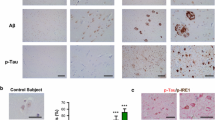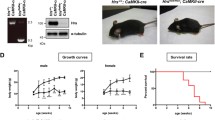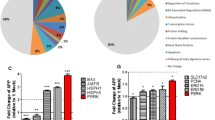Abstract
Endoplasmic reticulum (ER) stress triggers multiple cellular signals to restore cellular function or induce proapoptosis that is altered in the brains of patients with Alzheimer’s disease (AD). However, the role of ER stress in β-amyloid (Aβ)-induced AD pathology remains elusive, and data obtained from different animal models and under different experimental conditions are sometimes controversial. The current study conducted in vivo genetic experiments to systematically examine the distinct role of each ER stress effector during disease progression. Our results indicated that inositol-requiring enzyme 1 was activated before protein kinase RNA-like endoplasmic reticulum kinase (PERK) activation in Aβ42 transgenic flies. Proteasome activity played a key role in this sequential activation. Furthermore, our study separated learning deficits from early degeneration in Aβ-induced impairment by demonstrating that X-box binding protein 1 overexpression at an early stage reversed Aβ-induced early death without affecting learning performance in the Aβ42 transgenic flies. PERK activation was determined to only enhance Aβ-induced learning deficits. Moreover, proteasome overactivation was determined to delay PERK activation and improve learning deficits. Altogether, the findings of this study demonstrate the complex roles of ER stress during Aβ pathogenesis and the possibility of using different ER stress effectors as reporters to indicate the status of disease progression.







Similar content being viewed by others
References
Pavitt GD, Ron D (2012) New insights into translational regulation in the endoplasmic reticulum unfolded protein response. Cold Spring Harb Perspect Biol 4(6). https://doi.org/10.1101/cshperspect.a012278
Li S, Yang L, Selzer ME, Hu Y (2013) Neuronal endoplasmic reticulum stress in axon injury and neurodegeneration. Ann Neurol 74(6):768–777. https://doi.org/10.1002/ana.24005
Chen L, Xu S, Liu L, Wen X, Xu Y, Chen J, Teng J (2014) Cab45S inhibits the ER stress-induced IRE1-JNK pathway and apoptosis via GRP78/BiP. Cell Death Dis 5(5):e1219. https://doi.org/10.1038/cddis.2014.193
Hoozemans JJ, Veerhuis R, Van Haastert ES, Rozemuller JM, Baas F, Eikelenboom P, Scheper W (2005) The unfolded protein response is activated in Alzheimer’s disease. Acta Neuropathol 110(2):165–172. https://doi.org/10.1007/s00401-005-1038-0
Mota SI, Costa RO, Ferreira IL, Santana I, Caldeira GL, Padovano C, Fonseca AC, Baldeiras I et al (2015) Oxidative stress involving changes in Nrf2 and ER stress in early stages of Alzheimer’s disease. Biochim Biophys Acta 1852(7):1428–1441. https://doi.org/10.1016/j.bbadis.2015.03.015
Kumar P, Ambasta RK, Veereshwarayya V, Rosen KM, Kosik KS, Band H, Mestril R, Patterson C et al (2007) CHIP and HSPs interact with beta-APP in a proteasome dependent manner and influence Abeta metabolism. Hum Mol Genet 16(7):848–864. https://doi.org/10.1093/hmg/ddm030
Soejima N, Ohyagi Y, Nakamura N, Himeno E, Iinuma KM, Sakae N, Yamasaki R, Tabira T et al (2013) Intracellular accumulation of toxic turn amyloid-is associated with endoplasmic reticulum stress in Alzheimer’s disease. Curr Alzheimer Res 10(1):11–20
Huang HC, Tang D, Lu SY, Jiang ZF (2015) Endoplasmic reticulum stress as a novel neuronal mediator in Alzheimer’s disease. Neurol Res 37(4):366–374. https://doi.org/10.1179/1743132814Y.0000000448
Salminen A, Kauppinen A, Suuronen T, Kaarniranta K, Ojala J (2009) ER stress in Alzheimer’s disease: a novel neuronal trigger for inflammation and Alzheimer’s pathology. J Neuroinflammation 6(1):41. https://doi.org/10.1186/1742-2094-6-41
Lee JH, Won SM, Suh J, Son SJ, Moon GJ, Park UJ, Gwag BJ (2010) Induction of the unfolded protein response and cell death pathway in Alzheimer’s disease, but not in aged Tg2576 mice. Exp Mol Med 42(5):386–394. https://doi.org/10.3858/emm.2010.42.5.040
Reinhardt S, Schuck F, Grösgen S, Riemenschneider M, Hartmann T, Postina R, Grimm M, Endres K (2014) Unfolded protein response signaling by transcription factor XBP-1 regulates ADAM10 and is affected in Alzheimer’s disease. FASEB J 28(2):978–997. https://doi.org/10.1096/fj.13-234864
Ma T, Trinh MA, Wexler AJ, Bourbon C, Gatti E, Pierre P, Cavener DR, Klann E (2013) Suppression of eIF2α kinases alleviates Alzheimer’s disease-related plasticity and memory deficits. Nat Neurosci 16(9):1299–1305. https://doi.org/10.1038/nn.3486
Hoozemans JJ, van Haastert ES, Nijholt DA, Rozemuller AJ, Eikelenboom P, Scheper W (2009) The unfolded protein response is activated in pretangle neurons in Alzheimer’s disease hippocampus. Am J Pathol 174(4):1241–1251. https://doi.org/10.2353/ajpath.2009.080814
Fonseca AC, Ferreiro E, Oliveira CR, Cardoso SM, Pereira CF (2013) Activation of the endoplasmic reticulum stress response by the amyloid-beta 1-40 peptide in brain endothelial cells. Biochim Biophys Acta 1832(12):2191–2203. https://doi.org/10.1016/j.bbadis.2013.08.007
Katayama T, Imaizumi K, Honda A, Yoneda T, Kudo T, Takeda M, Mori K, Rozmahel R et al (2001) Disturbed activation of endoplasmic reticulum stress transducers by familial Alzheimer’s disease-linked presenilin-1 mutations. J Biol Chem 276(46):43446–43454. https://doi.org/10.1074/jbc.M104096200
Pinton P, Giorgi C, Siviero R, Zecchini E, Rizzuto R (2008) Calcium and apoptosis: ER-mitochondria Ca2+ transfer in the control of apoptosis. Oncogene 27(50):6407–6418. https://doi.org/10.1038/onc.2008.308
Nakagawa T, Zhu H, Morishima N, Li E, Xu J, Yankner BA, Yuan J (2000) Caspase-12 mediates endoplasmic-reticulum-specific apoptosis and cytotoxicity by amyloid-beta. Nature 403(6765):98–103. https://doi.org/10.1038/47513
Katayama T, Imaizumi K, Manabe T, Hitomi J, Kudo T, Tohyama M (2004) Induction of neuronal death by ER stress in Alzheimer’s disease. J Chem Neuroanat 28(1–2):67–78. https://doi.org/10.1016/j.jchemneu.2003.12.004
Lee DY, Lee KS, Lee HJ, Kim DH, Noh YH, Yu K, Jung HY, Lee SH et al (2010) Activation of PERK signaling attenuates Abeta-mediated ER stress. PLoS One 5(5):e10489. https://doi.org/10.1371/journal.pone.0010489
Casas-Tinto S, Zhang Y, Sanchez-Garcia J, Gomez-Velazquez M, Rincon-Limas DE, Fernandez-Funez P (2011) The ER stress factor XBP1s prevents amyloid-beta neurotoxicity. Hum Mol Genet 20(11):2144–2160. https://doi.org/10.1093/hmg/ddr100
Kaneko M, Koike H, Saito R, Kitamura Y, Okuma Y, Nomura Y (2010) Loss of HRD1-mediated protein degradation causes amyloid precursor protein accumulation and amyloid-beta generation. J Neurosci 30(11):3924–3932. https://doi.org/10.1523/JNEUROSCI.2422-09.2010
Cissé M, Duplan E, Lorivel T, Dunys J, Bauer C, Meckler X, Gerakis Y, Lauritzen I et al (2016) The transcription factor XBP1s restores hippocampal synaptic plasticity and memory by control of the kalirin-7 pathway in Alzheimer model. Mol Psychiatry 22(11):1562–1575. https://doi.org/10.1038/mp.2016.152
Iijima K, Liu HP, Chiang AS, Hearn SA, Konsolaki M, Zhong Y (2004) Dissecting the pathological effects of human Abeta40 and Abeta42 in Drosophila: a potential model for Alzheimer’s disease. Proc Natl Acad Sci U S A 101(17):6623–6628. 36. https://doi.org/10.1073/pnas.0400895101
Iijima K, Chiang HC, Hearn SA, Hakker I, Gatt A, Shenton C, Granger L, Leung A et al (2008) Abeta42 mutants with different aggregation profiles induce distinct pathologies in Drosophila. PLoS One 3(2):e1703. 37. https://doi.org/10.1371/journal.pone.0001703
Wang L, Chiang HC, Wu W, Liang B, Xie Z, Yao X, Ma W, Du S et al (2012) Epidermal growth factor receptor is a preferred target for treating amyloid-β-induced memory loss. Proc Natl Acad Sci U S A 109(41):16743–16748. https://doi.org/10.1073/pnas.1208011109
Tully T, Quinn WG (1985) Classical conditioning and retention in normal and mutant Drosophila melanogaster. J Comp Physiol A 157(2):263–277. https://doi.org/10.1007/BF01350033
Tully T, Preat T, Boynton SC, Del Vecchio M (1994) Genetic dissection of consolidated memory in Drosophila. Cell 79(1):35–47. https://doi.org/10.1016/0092-8674(94)90398-0
McGuire SE, Mao Z, Davis RL (2004) Spatiotemporal gene expression targeting with the TARGET and gene-switch systems in Drosophila. Sci STKE 2004(220):pl6. https://doi.org/10.1126/stke.2202004pl6
Ryoo HD, Domingos PM, Kang MJ, Steller H (2007) Unfolded protein response in a Drosophila model for retinal degeneration. EMBO J 26(1):242–252. https://doi.org/10.1038/sj.emboj.7601477
Akalal DB, Wilson CF, Zong L, Tanaka NK, Ito K, Davis RL (2006) Roles for Drosophila mushroom body neurons in olfactory learning and memory. Learn Mem 13(5):659–668. https://doi.org/10.1101/lm.221206
Laker RC, Xu P, Ryall KA, Sujkowski A, Kenwood BM, Chain KH, Zhang M, Royal MA et al (2014) A novel MitoTimer reporter gene for mitochondrial content, structure, stress, and damage in vivo. J Biol Chem 289(17):12005–12015. https://doi.org/10.1074/jbc.M113.530527
Gao XJ, Riabinina O, Li J, Potter CJ, Clandinin TR, Luo L (2015) A transcriptional reporter of intracellular Ca(2+) in Drosophila. Nat Neurosci 18(6):917–925. https://doi.org/10.1038/nn.4016
Kania E, Pająk B, Orzechowski A (2015) Calcium homeostasis and ER stress in control of autophagy in cancer cells. Biomed Res Int 2015:352794
Krebs J, Agellon LB, Michalak M (2015) Ca(2+) homeostasis and endoplasmic reticulum (ER) stress: an integrated view of calcium signaling. Biochem Biophys Res Commun 460(1):114–121. https://doi.org/10.1016/j.bbrc.2015.02.004
Kawasaki F, Felling R, Ordway RW (2000) A temperature-sensitive paralytic mutant defines a primary synaptic calcium channel in Drosophila. J Neurosci 20(13):4885–4889
Kang K, Ryoo HD, Park JE, Yoon JH, Kang MJ (2015) A Drosophila reporter for the translational activation of ATF4 marks stressed cells during development. PLoS One 10(5):e0126795. https://doi.org/10.1371/journal.pone.0126795
Nunziante M, Ackermann K, Dietrich K, Wolf H, Gädtke L, Gilch S, Vorberg I, Groschup M et al (2011) Proteasomal dysfunction and endoplasmic reticulum stress enhance trafficking of prion protein aggregates through the secretory pathway and increase accumulation of pathologic prion protein. J Biol Chem 286(39):33942–33953. https://doi.org/10.1074/jbc.M111.272617
Vincenz L, Jäger R, O’Dwyer M, Samali A (2013) Endoplasmic reticulum stress and the unfolded protein response: targeting the Achilles heel of multiple myeloma. Mol Cancer Ther 12(6):831–843. https://doi.org/10.1158/1535-7163.MCT-12-0782
Ruggiano A, Foresti O, Carvalho P (2014) Quality control: ER-associated degradation: protein quality control and beyond. J Cell Biol 204(6):869–879. https://doi.org/10.1083/jcb.201312042
Pandey UB, Nie Z, Batlevi Y, McCray BA, Ritson GP, Nedelsky NB, Schwartz SL, DiProspero NA et al (2007) HDAC6 rescues neurodegeneration and provides an essential link between autophagy and the UPS. Nature 447(7146):859–863. https://doi.org/10.1038/nature05853
Tonoki A, Kuranaga E, Tomioka T, Hamazaki J, Murata S, Tanaka K, Miura M (2009) Genetic evidence linking age-dependent attenuation of the 26S proteasome with the aging process. Cell Biol 29(4):1095–1106
Bader M, Benjamin S, Wapinski OL, Smith DM, Goldberg AL, Steller H (2011) A conserved F box regulatory complex controls proteasome activity in Drosophila. Cell 145(3):371–382. https://doi.org/10.1016/j.cell.2011.03.021
Marcu MG, Doyle M, Bertolotti A, Ron D, Hendershot L, Neckers L (2002) Heat shock protein 90 modulates the unfolded protein response by stabilizing IRE1alpha. Mol Cell Biol 22(24):8506–8513. https://doi.org/10.1128/MCB.22.24.8506-8513.2002
Romero-Ramirez L, Cao H, Nelson D, Hammond E, Lee AH, Yoshida H, Mori K, Glimcher LH et al (2004) XBP1 is essential for survival under hypoxic conditions and is required for tumor growth. Cancer Res 64(17):5943–5947
Hetz C, Saxena S (2017) ER stress and the unfolded protein response in neurodegeneration. Nat Rev Neurol 13(8):477–491. https://doi.org/10.1038/nrneurol.2017.99
Garcia-Huerta P, Bargsted L, Rivas A, Matus S, Vidal RL (2016) ER chaperones in neurodegenerative disease: folding and beyond. Brain Res 1648(Pt B):580–587
Lee AH, Iwakoshi NN, Anderson KC, Glimcher LH (2003) Proteasome inhibitors disrupt the unfolded protein response in myeloma cells. Proc Natl Acad Sci U S A 100(17):9946–9951. https://doi.org/10.1073/pnas.1334037100
Lisbona F, Rojas-Rivera D, Thielen P, Zamorano S, Todd D, Martinon F, Glavic A, Kress C et al (2009) BAX Inhibitor-1 is a negative regulator of the ER stress sensor IRE1α. Mol Cell 33(6):679–691. https://doi.org/10.1016/j.molcel.2009.02.017
Selkoe DJ (2002) Alzheimer’s disease is a synaptic failure. Science 298(5594):789–791
Luo LQ, Martin-Morris LE, White K (1990) Identification, secretion, and neural expression of APPL, a Drosophila protein similar to human amyloid protein precursor. J Neurosci 10(12):3849–3861
Acknowledgements
We thank Dr. Kuei-Sen Hsu for the comments on the manuscript. We also thank Drs. Y. Zhong, P. Fernandez-Funez, S. Marciniak, U.B. Pandey, R. W. Ordway, M.J. Kang, L. Luo, M. Miura, and H. Steller; Bloomington Stock Center; VDRC, Vienna; and FlyORF for providing the experimental materials. Special thanks to the technical services from the “Bio-image Core Facility of the National Core Facility Program for Biotechnology, Ministry of Science and Technology, Taiwan.”
Funding
This work was supported by the Ministry of Science and Technology, Taiwan (MOST 104-2320-B-006-037-MY3 to H.C. Chiang).
Author information
Authors and Affiliations
Corresponding author
Ethics declarations
Conflict of Interest
The authors declare that they have no conflict of interests.
Electronic supplementary material
ESM 1
(DOCX 339 kb)
Rights and permissions
About this article
Cite this article
Cheng, KC., Chiang, HC. XBP1 and PERK Have Distinct Roles in Aβ-Induced Pathology. Mol Neurobiol 55, 7523–7532 (2018). https://doi.org/10.1007/s12035-018-0942-y
Received:
Accepted:
Published:
Issue Date:
DOI: https://doi.org/10.1007/s12035-018-0942-y




